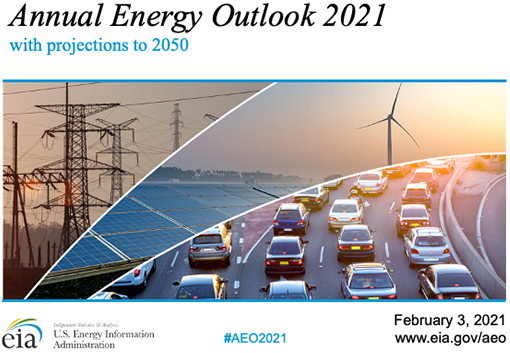The wealth of information available to today’s energy professionals can seem overwhelming at times. With so much coming at you at once, where should you direct your attention? Each issue, energy.ink’s Data Dive features one informational report, study or survey worthy of closer inspection.
 The U.S. Energy Information Administration (EIA) released its Annual Energy Outlook 2021 with projections to 2050. Notably, this year’s Annual Energy Outlook dedicates two full pages to liquid biofuels, a sector EIA sees recovering from the COVID-19 fallout faster than petroleum. Indeed, EIA highlighted increasing consumption of biofuels as a takeaway from the report’s Reference and side cases.
The U.S. Energy Information Administration (EIA) released its Annual Energy Outlook 2021 with projections to 2050. Notably, this year’s Annual Energy Outlook dedicates two full pages to liquid biofuels, a sector EIA sees recovering from the COVID-19 fallout faster than petroleum. Indeed, EIA highlighted increasing consumption of biofuels as a takeaway from the report’s Reference and side cases.
As a quick reference tool for readers, here are some of energy.ink’s highlights of this year’s Annual Energy Outlook:
- In the High Oil Price side case, biofuels represent nearly 15 percent of all U.S. gasoline and diesel consumption by 2050
- Even in the Low Oil Price case, biofuels represent nearly 10 percent of U.S. gasoline and diesel consumption by 2050
- In its Reference case, EIA projects diesel demand will return to pre-COVID levels in 2021
- U.S. biodiesel production is expected to grow steadily through 2050
- Though the market for electric vehicles continues to grow, they still represent a relatively low share of new vehicles through 2050
- Gasoline and flex-fuel vehicles (which can use up to E85) account for 79 percent of new vehicles in 2050
As a final note, it’s worth considering that for the second year in a row, EIA has also included High Renewables Cost and Low Renewables Cost side cases in its projections. These side cases assume costs either rise or fall depending on technological adoption and “learning by doing,” so if there’s a high learning rate for renewables through 2050, their costs fall by 40 percent compared to the costs included in the Reference case.
With the new presidential administration establishing renewable energy as a high priority from out the proverbial gate, energy analysts in the public and private sectors will likely be looking very closely at the Low Renewables Cost case.
